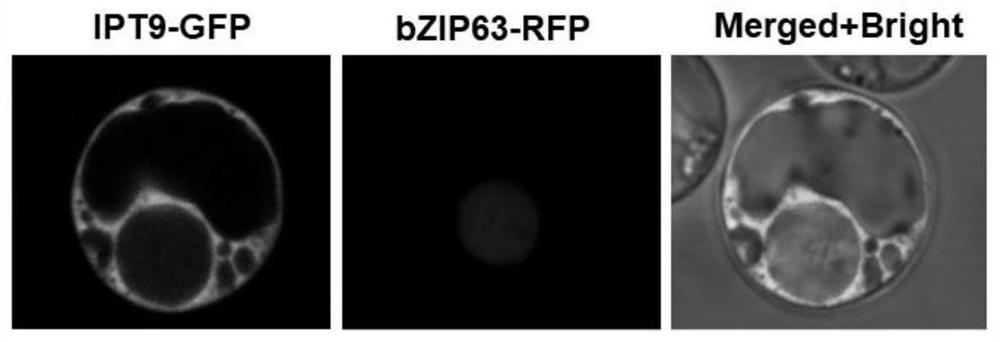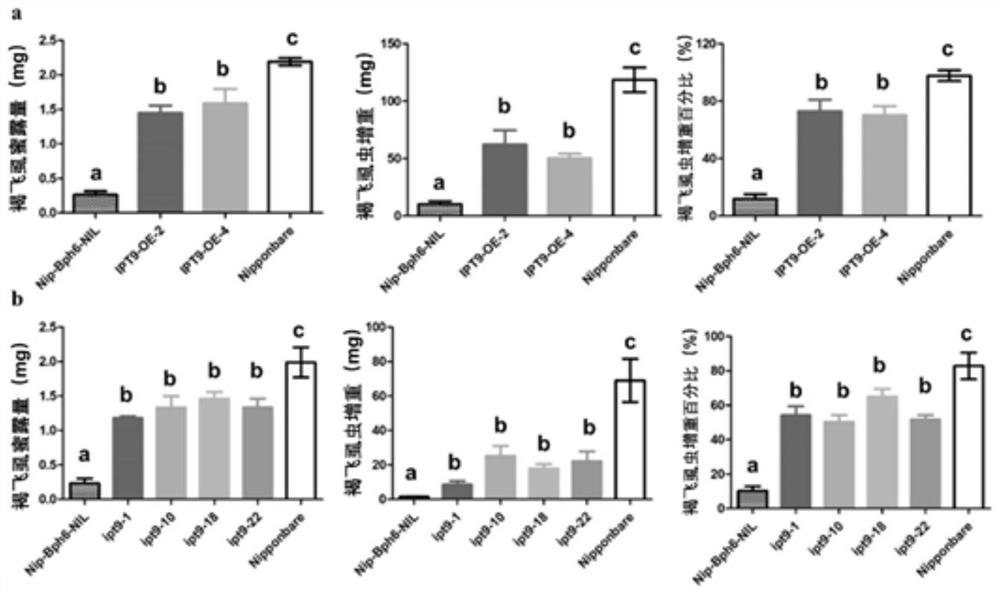Application of rice tRNA prenyltransferase gene osipt9 in resistance to brown planthopper in rice
A technology against brown planthopper and isopentenyl, which is applied in the field of plant genetic engineering and can solve the problems of failing to detect cZ
- Summary
- Abstract
- Description
- Claims
- Application Information
AI Technical Summary
Problems solved by technology
Method used
Image
Examples
Embodiment 1
[0035] [Example 1] Acquisition of rice OsIPT9 gene
[0036] A tRNA isopentenyltransferase OsIPT9 was found by screening interacting proteins in the rice 9311 library against the brown planthopper gene Bph6, and the ORF sequence and genome sequence of the gene were amplified in the cDNA of Nipponbare by designing primers.
Embodiment 2
[0037] [Example 2] Subcellular localization of rice OsIPT9 gene
[0038] Primers were designed at both ends of the full-length ORF of the OsIPT9 gene, and BamHI restriction sites and protective bases were added. After the amplified fragment was recovered, it was digested with BamHI enzyme and connected to the vector PCXUN::GFP digested with the same enzyme. , The positive clones were sent for sequencing, and it was confirmed that there was no mutation in the forward connection to extract the plasmid, and the plasmid was transformed into protoplasts. The specific process is as follows:
[0039] The rice seeds were sown in 1 / 2 MS medium, and cultured in a dark incubator at 28°C for 10 to 12 days. Take about 100 seedlings, cut the stems into small pieces of about 0.5mm with a blade, equilibrate in 0.6M mannitol for 10 minutes, transfer them to the enzymatic hydrolysis solution, and culture them in the dark at 28°C and 80rpm for 4-5h. Add 10 ml of W5 solution to the enzymolysis ...
Embodiment 3
[0040] [Example 3] Overexpression of OSIPT9 gene, construction of CRISPR / Cas9 vector and genetic transformation mediated by Agrobacterium
[0041] 1. Construction of OsIPT9 overexpression vector
[0042] The inventors intercepted a section of primers at both ends of the ORF of OsIPT9, and the sequence is as follows:
[0043] OEV-F:ATGGCCCACCTCGCGGCCTCTG(5'-3')
[0044] OEV-R:CTATAATGATATCACTGTACTAGCC(5'-3')
[0045] The vector used is pCXUN (provided by Professor Wang Guoliang of Ohio State University in the United States). The pCXUN vector is cut with XcmI, and the foreign fragment can be directly connected after adding A. According to the sequence of SEQ ID No.2, the ORF was directly amplified by PCR, and connected to the vector after adding A. After the sequence verification is correct, the obtained vector is the OsIPT9 gene overexpression vector, which is electrotransformed into Agrobacterium EHA105. Pick a single clone for expansion and culture, and after PCR verifica...
PUM
 Login to View More
Login to View More Abstract
Description
Claims
Application Information
 Login to View More
Login to View More - R&D
- Intellectual Property
- Life Sciences
- Materials
- Tech Scout
- Unparalleled Data Quality
- Higher Quality Content
- 60% Fewer Hallucinations
Browse by: Latest US Patents, China's latest patents, Technical Efficacy Thesaurus, Application Domain, Technology Topic, Popular Technical Reports.
© 2025 PatSnap. All rights reserved.Legal|Privacy policy|Modern Slavery Act Transparency Statement|Sitemap|About US| Contact US: help@patsnap.com



